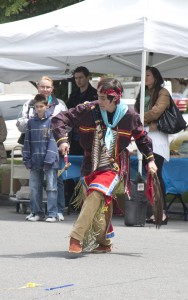BYU’s Museum of Peoples and Cultures held its annual block party, focusing the event on technology through time on Saturday, May 10, outside the museum.
Free booths lined the street reviewing different parts of past culture. Some focused on hunting and fishing, while others taught about clothing and food.
Adults in traditional clothing and children with beaded shoes stood near the booths while visitors ground maize, shaved rocks and crocheted lace. Animal skins hung next to a traditional tepee as guests listened to volunteers talk about past culture.
One of the larger demonstrations showed a traditional dance.
A man danced symbolically as a flower and bird. The visitors cheered as he moved green hoops around and over his body into different shapes. Accompanying him was a man called Morning Star who sang and pounded on a drum. His message was clear:

“We are all related. Find your gift and strengthen our circle,” Morning Star said.
After his speech, Morning Star had everyone come together in a simple dance called the “circle of friendship.” The circle was largely made up of students and families joining hands, each with a different heritage.
Between the larger demonstrations guests were welcome to experience the different parts of culture and eat refreshments.
The first booth described the homes created by the Fremont Indians. They dug into flat ground and used sticks and adobe to build their homes. They built a fire right in the center underneath the stick roofs and next to the logs supporting the sides.
One of the volunteers, Trevor Pollmann, explained how the adobe was similar to the material “used in the Provo Tabernacle.”
The Provo Tabernacle is not the same as the one standing today. Its original construction began in 1856 and was supposed to remind the youth of their parents’ religious heritage.
The new tabernacle was completed in 1885 while the original was used for recreation as well as meetings. Around 50 years after it was built, the original tabernacle was pulled down.
The Fremont Indians used similar adobe to create their homes; however, when they moved, they would fill their old homes with kindling and burn them down. It is unknown why they would choose to burn down their homes.
Another booth on the block showed intricate lace woven with small needle-like pointers. The women demonstrating would overlap the needles to create an intricate pattern. Examples of woven lace made by the women were placed under glass next to their work area.
After visiting all of the different booths, guest entered the building to view the museum.
Sarah Flinders, a graduate in American studies, volunteered within the museum. She described the beading on the clothes in the exhibits. They would make beads out of quills and bones, intricately threading them onto ceremonial clothes.
The beads you typically see on the shoes only came after the Europeans began to trade with them. Although many of the artifacts are centuries old, some are only several decades old.
“A big reason why they are so valuable is because a lot of the culture has gone away” Flinders said.
The Museum of Peoples and Cultures is located south of campus at 100 E. 700 North and is used as a teaching museum to remind viewers of their ancestors. The exhibits change occasionally, but each includes genuine artifacts and replicas.
The museum hosts guided tours as well as activities for date night, family home evening, cub scouts and boy scouts. Its mission is to educate visitors, collect artifacts and share the importance of ancestry and ancient culture.
As quoted on the wall in the museum by Andre Malraux explained, “Culture is the sum of all the forms of art, love, and of thought.”




